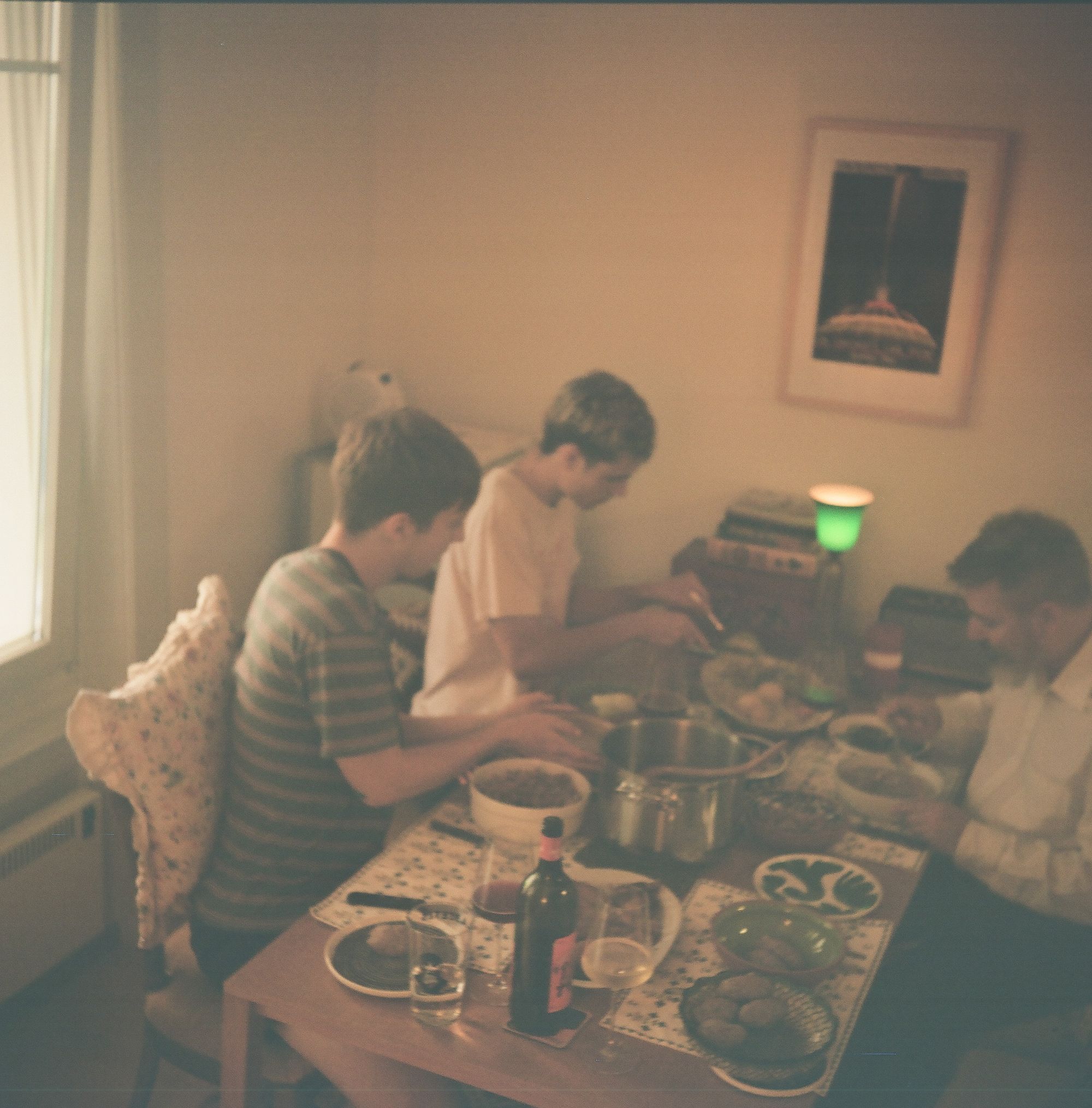What to eat ANDORRA 🇦🇩 Escudella
Escudella, the Pyrenean national dish of the Catalan principality of Andorra, dates back to medieval times. In essence, it is a pantry-clearing stew made of available vegetables, meats and legumes on hand that is hearty and satisfying, while remaining relatively healthy...

Escudella
Published November 10, 2023 · by Amanda Rivkin
Escudella, the Pyrenean national dish of the Catalan principality of Andorra, dates back to medieval times. In essence, it is a pantry-clearing stew made of available vegetables, meats and legumes on hand that is hearty and satisfying, while remaining relatively healthy. It contains different meats such as sausages, chicken, veal, and traditionally some interesting parts of the pig, including the snout, ears and trotters. Try it with these elements if you dare and have on hand.
The animals and vegetables are used to make a stock in which pasta is then added to at the very end. Potato may also be added, though it is less faithful to the medieval version given that potato is very much a new world vegetable.
In essence, though, escudella is one of these dishes where every family has their own variation and different holidays such as Christmas or the January feast of Saint Anthony (Sant Antoni in Catalan) are celebrated with different kinds of escudella. For Sant Antoni, online local news footage from the Andorran capital Andorra la Vella reveals huge stock pots of the stuff as part of the outdoor celebrations with queues around the corner and satisfied Andorrans soaking it all up.
Escudella may also be served with a crusty bread. The sausage traditionally used in escudella is called butifarra and it is among one of the most typical sausages of the region and Spain, spiced only lightly with salt and pepper so the pork can shine. The bone marrow of the meats provides for the intense flavor palette of the broth.
The pasta served with it is called galets and is a large elbow shaped pasta with one side decidedly more open than the other. Galets are most commonly associated with Christmas escudella in Andorra and the neighboring Spanish region of Catalonia.
As you make escudella — and it is a lengthy, time-consuming process — you can almost imagine ancient Catalonians tucked way up in the mountains of modern-day Andorra stirring hearty pots full of the stuff, taking their spoons and souping it in their gullets around long, last supper-like tables.
As it is a mountain dish made from simple and relatively unsophisticated ingredients, do not be surprised if your Swiss guests take a shine to it. Whereas Napoleon said Africa began at the Pyrenees, he said that centuries after escudella was invented. Save for the potatoes, there is nothing that is not basic European about it.
Recipe
Ingredients:
4 handfuls of dried garbanzo beans
2.75 kilos of lamb shank
700 grams of pork hocks
2 chicken legs
4 duck confit legs
2 large or 4 small carrots
3 mid-size potatoes
1 celery root
2 small onions
Half a head of cabbage
1 large leek
200 grams of large conchiglie noodles
1 bay leaf
Sea salt
Olive oil
For the pelotes:
1 kilo of ground beef, pork or lamb or a combination
1 head of garlic or 5-6 shallots
20 grams of parsley
1 large egg or 2 small eggs
2 handfuls of breadcrumbs
Sea salt
pepper
Directions:
Step 1: Take four handfuls of dried garbanzo beans and let soak in warm salt water overnight.
Step 2: Wash and dry the lamb. Cut the lamb shank into as few pieces as necessary to fit into your pot or kettle, leaving the bone in, and perhaps cut into it to fit the pot or kettle you are using, as was necessary when we made this dish. For this, a sharp serrated knife works best.
Step 3: Pour olive oil until the bottom of your kettle is full. Turn the heat on high. Add the lamb first as it will take the longest, sprinkling with salt to taste. Turn and simmer until golden brown on the outside.
Step 4: Add your pork hocks and two chicken legs. Sprinkle with salt.
Step 5: Pour cold water over everything and return to stove to boil. Once it begins to boil, turn the heat down low and cover. Let simmer for two hours until meat begins to fall off the bone, scraping off any foam that may gather at the top of the kettle as needed.
Step 6: Now it is time to prepare the vegetables based on what will take the longest. Use mesh vegetable bags to keep these groupings separate. The bags will go directly into the pot. Start with the potatoes, carrots, celery and onions in one bag. For the potatoes and carrots, peel and leave whole, unless using two large carrots, then cut those in half. For the celery root and onions, remove skin/exterior and then quarter them. Place all vegetables in this group into one vegetable bag and place in the pot that should be turned down to simmer by now.
Step 7: Now we turn our attention towards making rugby-shaped meatballs known as pelotes in Catalan. Chop your garlic or shallots and the parsley, combine in a bowl. Add two small eggs or one large egg and whisk.
Step 8: Add the ground meat and combine using your hands. Add breadcrumbs, salt and pepper. Combine with your hands.
Step 9: On a plate pour some flour. Shape the pelotes into rugby ball-shaped pelotes. Coat with flour and set on a tray. When done, place the entire tray in the refrigerator for now.
Step 10: Cut the half head of cabbage into two. Cut the leek into small pieces across. Drain garbanzo beans. Place all items in one vegetable bag.
Step 11: Turn on oven to 200 degrees centigrade to pre-heat.
Step 12: Scrape foam from top of pot and pull meat from the kettle and place on a platter to cool.
Step 13: When the meat comes out, add the second bag of vegetables containing the cabbage, leaks and garbanzo beans. Cover with approximately half a liter of water and two teaspoons of salt.
Step 14: Carve up the meat into small pieces. Set aside.
Step 15: Put the pelotes in the freezer for 5-10 minutes.
Step 16: Place duck confit on a tray and place in oven for 5-10 minutes. When done, pull from the oven and place on your table to cool. The confit is a substitute for quality Spanish pork sausages known as butifarra.
Step 17: Pull the first bag of vegetables out of the pot and discard the celery root. Arrange the remaining vegetables nicely on a platter.
Step 18: Pull the meatballs from the freezer. They will be boiled in the stock and placed on a serving dish. Turn up the heat slightly to a medium-low heat to boil the pelotes. If you turn the heat up too high, you risk the pelotes breaking apart.
Step19: Remove second bag of vegetables when it looks ready. Add to your vegetable platter.
Step 20: Finally, add your large, elbow shaped noodles known in Catalan as galets. In Switzerland, large conchiglie is a close approximation to the Catalan noodle. I added about 200 grams of noodles. It is possible to cook the pelotes and noddles at once if pressed for time.
Step 21: Pull the pelotes from the soup with care when the noodles are done. They should float to the top. Arrange all your meats and vegetables on the table and ladle soup with galets for your guests. Allow them to add the meats to the soup or have as a side as they wish.
Tips, tricks & notes:
The traditional sausage used for escudella is called butifarra and is a simple pork sausage seasoned only with salt and pepper. Ticinese, merguez and other sausages typically found in Switzerland do not compare and are way too seasoned for this dish. For this reason, I added duck confit as an additional side, but substitute a meat of your choice. When in doubt, I tend to go gourmet.
Traditionally, the butifarra is boiled at the end, before or with the pelotes. If substituting, I would caution against boiling the meat in your stock and suggest baking an additional meat instead so as to not confuse the flavor palette of your broth. The duck worked nicely.
In Bern, I found the large conchiglie pasta at Alnatura, the Migros-owned organic food store. All the meats I found at either Aligro or Denner. All three have many locations across Switzerland.
This dish was a huge hit with our guests, perhaps because to the surprise of no one, mountain people like the Swiss enjoy mountain foods like those found in the Pyrenees.

Learn where to eat Andorran-inspired food in Switzerland.
Follow our social media pages @swissglobaldining on Instagram, TikTok and YouTube